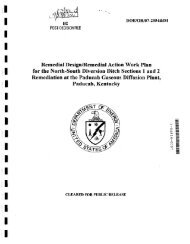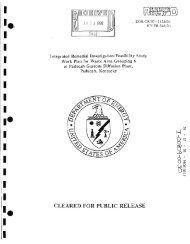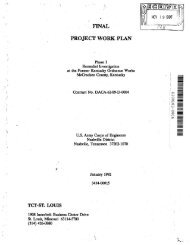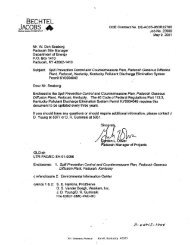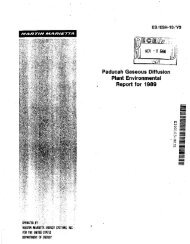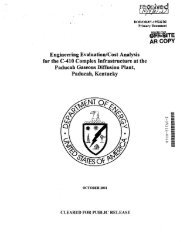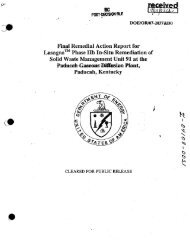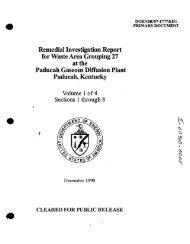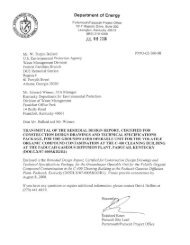1 - paducah environmental information center
1 - paducah environmental information center
1 - paducah environmental information center
Create successful ePaper yourself
Turn your PDF publications into a flip-book with our unique Google optimized e-Paper software.
Paducah Site<br />
radiation is about 27 mrem (0.27 mSv) (NCRP<br />
1987); The average annual dose from cosmic<br />
radiation received by residents in the Paducah<br />
area is about 45 mrem (0.45 mSv).<br />
Dose from Terrestrial Radiation<br />
The average annual dose received from<br />
terrestrial gamma radiation is about 28 mrem<br />
(0.28 mSv) in the United States. This dose varies<br />
geographically across the country (NCRP<br />
1987); typical reported values are 16 mrem (0.16<br />
mSv) at the Atlantic and Gulf coastal plains and<br />
63 mrem (0.63 mSv) at the eastern slopes of the<br />
Rocky Mountains. In the Paducah area,<br />
background levels of radionuclides in soils are<br />
within typical levels indicating that the dose<br />
received from terrestrial gamma radiation is<br />
within the range of typical reported values<br />
discussed previously (DOE 1997);<br />
Dose from Internal Radiation<br />
Short-lived decay products of radon are the<br />
major contributors to the annual dose equivalent<br />
for internal radionuclides (mostly 222Rn). They<br />
contribute an average dose of about 200 mrem<br />
(2.00 mSv) per year. This dose estimate is based<br />
on an average radon concentration of about 1<br />
pCiIL (0.037 Bq/L) (NCRP 1987).<br />
The average dose from other internal<br />
radionuclides is about 39 mrem (0.39 mSv) per<br />
year, most of which can be attributed to the<br />
naturally occurring isotope of potassium, 4OK.<br />
The concentration of radioactive potassium in<br />
human tissues is similar in all parts of the world.<br />
Dose from Consumer Products<br />
Dose from Medical Sources<br />
Nuclear medicine examinations, which<br />
involve the internal administration of<br />
radiopharmaceuticals, generally account for the<br />
largest portion of the dose received from humanmade<br />
sources. However, the radionuclides used<br />
in specific tests are not distributed uniformly ,<br />
throughout the body. In these cases,<br />
comparisons are made using the concept of<br />
EDE, which relates exposure of organs or body<br />
parts to one effective whole-body dose. The<br />
average annual EDE from medical examinations<br />
is 53 mrem (0.53 mSv), including 39 mrem (0.39<br />
mSv) for diagnostic X rays and 14 mrem (0. 14<br />
mSv) for nuclear medicine procedures (NCRP<br />
. 1989). The actual doses received by individuals<br />
who complete such medical exams are much<br />
higher than these values, but not everyone<br />
receives such exams each year (NCRP 1989).<br />
Dose from Other Sources<br />
Small doses received by individuals occur<br />
as a result of radioactive fallout from<br />
atmospheric atomic weapons tests, emissions of<br />
radioactive materials from nuclear facilities,<br />
elDlSSlOns from certain mineral extraction<br />
facilities, and transportation of radioactive<br />
materials. The combination of these sources<br />
coptributes less than 1 mrem (0.01 mSv) per year<br />
to the average dose to an individual (NCRP<br />
1987).<br />
A comprehensive EPA report of 1984<br />
projected ,the average occupational dose to<br />
monitored radiation workers in medicine,<br />
industry, the nuclear fuel cycle, government,<br />
and miscellaneous industries to be 105 mrem<br />
(1.05 mSv) per year for 1985, down slightly<br />
from 110 mrem (1.10 mSv) per year in 1980<br />
(Kumazawa et al. 1984).<br />
The U.S. average annual dose received by<br />
an individual from consumer products is about<br />
10 mrem (0.10 mSv) (NCRP 1987).<br />
A-6<br />
Appendix A



